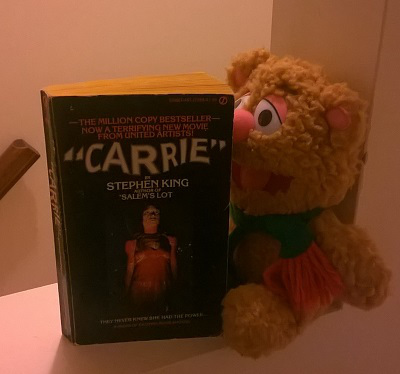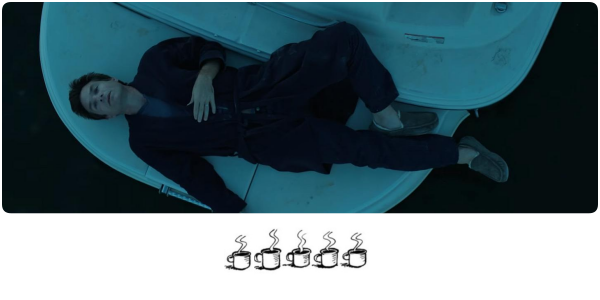 [Explanation of Reading Journal Entries/Ratings]
[Explanation of Reading Journal Entries/Ratings]
Post 2 [January 16th]
Stephen King’s first published novel, released in 1974. I read a movie tie-in paperback with a ton of typos.
3 out of 5 stars.
Times Read: At least 3.
Seen the Movie:
DePalma: Yes.
TV remake: No.
2013 Remake: Yes.
The Plot:
Bullied outcast Carrie White takes revenge against her classmates using her telekinetic powers.
It’s hard to give Carrie a fair rating. The story is so ingrained in public consciousness that it seems more classic fairy tale than modern novel. King brought a new archetype to the table to join Dracula and Frankenstein and Mr. Hyde and it’s easy to take that for granted. While reading Carrie again, I was sitting around a 2-star rating because I know the story too well at this point and I started fixating on the flaws instead of seeing the very cool aspects of its plot and presentation.
Carrie may have become so instantly iconic because it’s Cinderella in reverse. It hits fablelike beats through a distorted mirror. The crazy, heartbreaking thing about Carrie is, no matter how many times you read it, you always hope for things to go well. You think, maybe this time, it will turn out okay…
[1] Carrie is not a straight-forward third-person narrative but a short story nested inside fictional newspaper articles, excerpts from books about the Carrie White case, autobiographies, AP releases, etc. It’s an intriguing format which King uses to great effect to tease catastrophic events without saying exactly what’s going to happen. Very quickly, we know some terrible bloodbath is coming which will destroy much of this town. But we don’t know where or when. Instead, King gives comments like:
One of her surviving classmates, Ruth Gogan.
(p.10)
“And now there’s this other thing. No one can laugh that off, either. Too many people are dead.”
(p.36)
In the case of Carrie White, the only witness to any possible prologue to the final climactic events was Margaret White, and she, of course, is dead…
(p.65)
In the wake of two hundred deaths and the destruction of an entire town, it is so easy to forget one thing: We were kids.
(p.80)
The destruction that came to Chamberlain, Maine, in May of 1979.
(p.87)
Ross would have been offered a fairly large bonus for signing a contract, had he lived.
(p.89)
Finally, we’re told when the event will happen, but King still plays coy, never letting us forget that something terrible is on its way, down to the last moments:
There were only twelve survivors of what has become known in the popular press as Prom Night.
(p.89)
I hope it was good for her, that prom. Until the terror began, I hope it was good and fine.
(p.133)
[Tommy] and George and Frieda had less than two hours to live.
(p.136)
Tommy Ross, in the fading moments of his life now, took Carrie’s hand and grinned at her.
(p.163)
[2] Reference:
News item from the Westover (Me.) weekly Enterprise.
(p.3)
Westover is an invented town.
[3] Reference:
A rain of stones fell from a clear blue sky on Carlin Street in the town of Chamberlain.
(p.3)
Chamberlain is the name of an unincorporated village in the town of Bristol, Lincoln County in Maine. The Chamberlain in Carrie, bordering Lewiston, is an invention of King’s.
The childhood stones-falling-on-house incident is a clear nod to Shirley Jackson’s The Haunting of Hill House, whose main character Eleanor Vance had a similar experience. King’s love for Jackson’s novel is clear whenever he mentions it – he quoted it directly in Part One of Salem’s Lot (note [6]) and referenced it several times in It (note [206]). I think King also reuses the stones-on-house backstory for a character in the Rose Red miniseries.
[4]
Nobody was really surprised when it happened, not really, not at the subconscious level where savage things grow.
(p.3)
[5] There’s some weird prose in this book; a bit of a pulp, soft-core feel:
The girls had been playing volleyball in Period One, and their morning sweat was light and eager.
Girls stretched and writhed under the hot water, squalling, flicking water, squirting white bars of soap from hand to hand.
(p.4)
(Side thought: Carrie’s first period coming after Period One can’t be incidental.)
[6] Carrie in the book is a large, unattractive young woman instead of the waifish figure of every film. Someday, I’d love to see a shorter, chubby Carrie:
Carrie stood among them stolidly, a frog among swans. She was a chunky girl with pimples on her neck and back and buttocks.
(p.4)
Even Carrie’s mother is described as large, which the movies refuse to do:
Momma was a very big woman and she always wore a hat.
(p.52)
Psycho (note [2]) had this element, too; Norman Bates is a chubby, unattractive man in the book and a thin, attractive man in Hitchcock’s film.
(Another random thought: the name Carrie White is so elegant and beautiful, while the beautiful semi-heroic Sue Snell gets the “ugly” name. No offense to any Sue Snells.)
[7] Something I never picked up on until this reading: Carrie is set in the future. It was published in 1974 but the events of the “Black Prom” take place in 1979. I don’t know why King chose to do this (he also set The Stand in the future from publication date). He may have been thinking of how long books can take to be completed and published and didn’t want it to be immediately dated. Or he just felt like pushing it toward the next decade.
Though there seems to be a continuity error with Carrie’s age and birthday.
Carrie White’s mother, Margaret White, gave birth to her daughter on September 21, 1963.
(p.13)
In the opening shower scene, Sue places Carrie’s age as sixteen:
Sixteen? [Sue] was thinking. She must know what’s happening, she-
(p.7)
This would place the prom in May 1980, but later we’re told the “Black Prom” takes place in May 1979 (when Carrie would be four months away from turning sixteen).
“Graduation slated June seventy-nine; next month.”
(p.69)
Later, Sue Snell, in her “autobiography” says:
Carrie was seventeen, Chris Hargensen was seventeen, I was seventeen, Tommy Ross was eighteen.
(p.80)
Sue’s thoughts in the shower (p.7) are probably just a mistake but a weird mistake since she knows the correct age later. It seems especially bizarre that Carrie, a sixteen-year-old who’s not especially noted for her intelligence, is about to graduate high school.
[8] Reference:
I found this love letter from Carrie to Flash Bobby Pickett.
(p.8)
Bobby Pickett (1938-2007) was an American singer who was known for co-writing and performing the 1962 hit novelty song “Monster Mash.” The track re-entered the U.S. charts twice, in August 1970, and again in May 1973, when it reached the #10 spot.
I can’t find any reference to Pickett being called “Flash,” so I’m not sure if this was a “love letter” that Carrie wrote to the singer Bobby Pickett or if King is implying there was a kid in town with the same name who people called Flash.
[9] Ironic in light of later events:
Chris Hargensen called up after school (…) and asked [Carrie] if she knew that pig poop was spelled C-A-R-R-I-E.
(p.9)
[10] Reference:
Three letters to a friend in Kenosha, Wisconsin.
(p.14)
Kenosha is a city in and the county seat of Kenosha County, Wisconsin. Kenosha is on the southwestern shore of Lake Michigan. It’s population was estimated around 100,000 in July 2013.
[11]
He glared over Desjarden’s shoulder at the boys, who were staring at the bloody handprint on her shorts. “What are you looking at?”
“Blood,” Henry said, and smiled with a kind of vacuous surprise.
(p.15)
[12] By the publication of On Writing (2000), King was staunchly against unnecessary adverbs in dialogue attributions.
The best form of dialogue attribution is said (…) You need only look back through some of my own fiction to know that I’m just another ordinary sinner (…) When I do it, it’s usually for the same reason any writer does it: because I am afraid the reader won’t understand me if I don’t.
(On Writing, p.120-21)
At this point, he hadn’t learned the lesson yet and was apparently very afraid. From a single page of Carrie:
“White,” Morton agreed. (…)
“Week’s detention!” Morton barked (…)
“You can go now, Cassie,” he said magnanimously.
“That’s not my name!” she screamed suddenly.
(p.16)
King might be doing it for humor here and it works well enough but I agree with the man: said is best.
[13] Reference:
“Chris and her Mortimer Snerds.”
(p.20)
Mortimer Snerd was referenced in The Last Picture Show (note [16]), so hopefully I’ll remember from now on.
Edgar Bergen (1903 – 1978) was an American actor, comedian and radio performer, best known for his proficiency in ventriloquism and his characters Charlie McCarthy and Mortimer Snerd. Mortimer Snerd was developed as a character for a radio program. He was a red-headed buck-toothed, goofy-looking doll.
[14]
“Um,” Mr. Morton repeated wisely. He did not understand women and had no urge at all to discuss menstruation.
(p.20)
[15]
He yelled something at her, but she ignored it. She had been yelled at by experts.
(p.24)
[16] More often than not, the Book of Revelation is incorrectly called “the Book of Revelations” in novels and I don’t know how some editor/reader along the line doesn’t fix it.
Her eyes were hot, as if she had just sat down and read the Book of Revelations straight through.
(p.25)
[17]
“Ralph was a construction worker, and people on the street said he carried a Bible and a .38 revolver to work with him every day. The Bible was for his coffee break and lunch. The .38 was in case he met Antichrist on the job.”
(p.27)
[18] References:
Stella Horan lived on Carlin Street until she was twenty, commuting to day classes at Lewin Business College in Motton.
(p.27)
Inventions of King’s.
[19] Reference:
“A plain old one-piece Jantzen [bathing suit].”
(p.28)
Jantzen is a brand of swimwear that was established in 1916 and first appeared in the city of Portland, Oregon. Their logo, of a woman in a one-piece red swimsuit, is one of the longest lived apparel icons.
[20]
“She came home from Jordan Marsh with a little white bikini.”
(p.28)
Jordan Marsh & Company was a department store in Boston (founded 1841) which grew to be a major regional chain in the New England area. In 1996, the last of the Jordan Marsh stores were converted to Macy’s. It was named for the two founders, Eben Dyer Jordan and Benjamin L. Marsh. For years the flagship store in Boston was home to the Enchanted Village, a lavish Christmas display.
[21] Vocabulary:
“I was logy from the sun.”
(p.30)
adjective – (North American) – dull and heavy in motion or thought; sluggish.
[22] Reference:
The only sound was the ticking of the Black Forest cuckoo clock.
(p.37)
Craftsmanship of Black Forest clockmakers dates back to the mid-17th century. A specialized branch of Black Forest clockmakers are the manufacturer of cuckoo clocks. The Black Forest is a large forested mountain range in the state of Baden-Wurttemberg in south-west Germany.
[23] Kingism:
Mama had battled the Black Man and had vanquished him.
(p.42)
King likes to use “The Black Man” or “The Man in Black” as a source of evil.
[24] Reference:
Like the Flatlands Society, the Rosicrucians, or the Corlies of Arizona, who are positive that the atomic bomb does not work, these unfortunates are flying in the face of logic with their heads in the sand.
(p.50)
I can’t figure out who the Corlies of Arizona are supposed to be. It could be a typo or a King invention, but it’s put alongside two real groups.
[25] References:
Listening to Tennessee Ernie Ford singing “Let the Lower Lights Be Burning” (…)
Mr. P.P. Bliss, who had written this hymn and others seemingly without number.
(p.51)
Ernest Jennings Ford (1919-1991), known professionally as Tennessee Ernie Ford, was an American recording artist and television host who enjoyed success in the country and Western, pop, and gospel music genres.
“Let the Lower Lights Be Burning” is a hymn written by Philip Paul Bliss (1838-1876). Information about Bliss can be found on the University of Chicago site.
[26] References:
Derrault’s conception of Jonathan Edwards’ famous sermon, Sinners in the Hands of an Angry God.
(p.54)
The (assumed from context) artist Derrault seems to be an invention of King’s or a typo that originated with him – most of the hits that come back from a search of that name are other people trying to search for it because of Carrie.
Margaret White’s later counterpart Mrs. Carmody from “The Mist” (notes [99]; [106]) is also a fan of revivalist and preacher Jonathan Edwards (1703-1758).
Edwards’ sermon “Sinners in the Hands of an Angry God” was preached to his own congregation in Northampton, Massachusetts (on an unknown date?) and again on July 8, 1741 in Enfield, Connecticut. Like Edwards’ other works, it combines vivid imagery of Hell with observations of the world and citations of the scripture. It is Edwards’ most famous written work.
Post 2 [January 16th]
Advertisements Share this:




